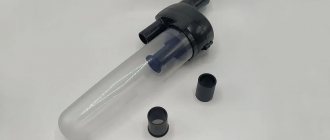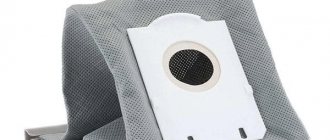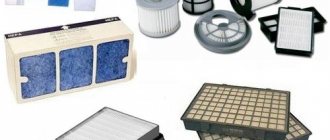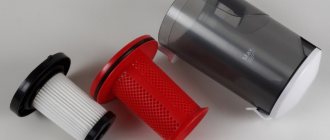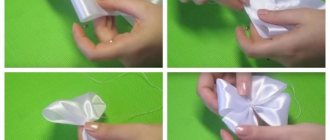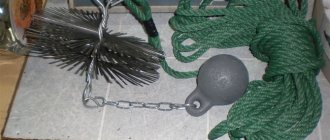Technological progress does not stand still: cleaning with the help of modern gadgets is much easier than ten years ago.
For example, almost no one uses vacuum cleaners with garbage bags anymore.
But modern models, such as vacuum cleaners with cyclone filters, are popular, and their pros and cons are actively discussed on the relevant forums.
How does a cyclone filter work?
The principle of operation of the cyclone filter is to clean the air coming out of the vacuum cleaner. As the vacuum cleaner sucks in air, debris enters the cyclone filter from the side, thereby creating spiral movements.
Large debris is usually attracted to the walls, and dust swirls around the filter. When the air flow reaches the end of the filter, it reverses its direction and suddenly loses speed. This process allows large debris to fall into the dust bin. Next, the air, cleared of debris, comes out through the exhaust hole of the vacuum cleaner.
Efficiency[edit | edit code]
The degree of cleaning in a cyclone strongly depends on the dispersed composition of dust particles in the gas supplied for cleaning (the larger the particle size, the more effective the cleaning). For common cyclones of the CN type, the degree of purification can reach:
| for particles with a nominal diameter of 20 microns | 99,5 % |
| for particles with a nominal diameter of 10 microns | 95 % |
| for particles with a nominal diameter of 5 microns | 83 % |
As the diameter of the cyclone decreases, the degree of purification increases, but the metal consumption and cleaning costs increase. For large volumes of gas and high purification requirements, the gas flow is passed in parallel through several small-diameter cyclones (100-300 mm). This design is called a multicyclone or battery cyclone. It is also possible to use an electrostatic filter, which, on the contrary, is effective specifically for small particles.
Pros and cons of a cyclone
The main advantages of a cyclone filter:
- deep cleaning of the surface due to multi-level filtration;
- minimal dust emissions when air exits the vacuum cleaner;
- convenient cleaning of the filter and dust collector;
- compactness, since the filter usually has small dimensions (one of the reasons for its frequent use on vertical vacuum cleaners);
- the ability to wash all parts of the structure;
- The absence of dust bags saves money.
Also worth noting is the strength of the filter container, which, unlike cloth or paper bags, can hold back glass or nails. Typically, vacuum cleaners with cyclone filters have filling indicators, but if they are absent, clogging can be determined by a decrease in suction power.
With all its advantages, the cyclone filter also has a number of disadvantages:
- rapid reduction in power when clogged;
- increased noise level;
- increased cleaning time due to low power;
- passage of small dust particles.
Since in standard models of vacuum cleaners with cyclone filters, dust microparticles fly out with the exhaust air stream, it is recommended for allergy sufferers to purchase a model with an aquafilter and an increased level of filtration.
Weaknesses of innovative technology and their impact on product functionality
Unfortunately, ideal cleaning devices have not yet been invented. Even such a convenient and functional cyclone filter, and the device constructed on its basis, has a number of shortcomings. If you learn about them in advance and prepare for the peculiarities of operation, the disadvantages will not seem so significant.
- Collecting very thin, light, almost weightless particles can be difficult. Such a vacuum cleaner is not suitable for cleaning fluff, hair, threads, and animal fur.
- In the process of creating internal vortices, the device begins to create and accumulate static electricity. After some time, it begins to spread to the body. Receiving a blow of such force is not dangerous to health, but is quite sensitive and unpleasant.
- The speed of operation of the device has a direct impact on the quality of suction. If it suddenly falls sharply (this happens when curtains or upholstery are sucked in), the artificial vortex is destroyed, the debris is no longer contained and stains the filter. After fixing the problem, the vacuum cleaner takes time to gain speed.
- The appliance will only work well if there is a stable air flow. There is no power regulator on these models.
- Specific sounds during the cleaning process. If medium or massive dense particles get into a plastic container, they hit the walls, leading to a very noticeable rumble.
- Inconvenience of the plastic case. Dirt particles passing through the containers scratch the plastic surface. After some time, the walls of the case become covered with such a dense network of scratches that they become cloudy. Because of this, it can be difficult to understand what condition the filter is in.
- Electricity costs. Powerful suction requires a lot of energy, so regular, high-quality cleaning of even a small area can add up to your utility bill.
Cyclone vacuum cleaner dustbin
Manufacturers are trying to combat the listed disadvantages of cyclone models, but so far without success. Consumers have to either accept these points or select analogues that are more suitable for their needs.
Types of cyclone filters
Vacuum cleaners are divided into three types: vertical, horizontal and automatic robotic. Each of them differs in maximum power and design. For example, in manual vacuum cleaners, the filters are located on the handle itself and are small in size, which makes them compact and quickly clog.
On standard vacuum cleaners, the cyclones are in a horizontal position and have large volumes, which increases the power and quality of cleaning. Robot vacuum cleaners have too small filters, so the quality of their cleaning is in last place, except for premium equipment with innovative technologies.
Depending on the type of vacuum cleaner, the appearance and design of the filter changes, but the procedure for creating an inertial flow is similar.
Construction [edit | edit code]
There is a huge variety of types of cyclones. In addition to the counter-flow cyclone described above, there are also less common direct-flow cyclones. Counterflow cyclones differ in size, the ratio of the cylindrical and conical parts, as well as the relative height (that is, the ratio of height to diameter) of the cylindrical part. The greater the relative height, the lower the coefficient of hydraulic resistance and the vacuum in the hopper (the less likelihood of dust being sucked into the apparatus), but the lower the degree of cleaning. The optimal relative height is 1.6, which corresponds to the “golden ratio” principle.
Vacuum cleaners with cyclone filter
The difference between a cyclone filter and others is the suction system and the method of processing debris. In appearance, this is an ordinary cylinder with a filter, but the procedure for drawing in and swirling the flow goes through several stages.
Design Features
Under the influence of centrifugal force, debris is separated from the air, which prevents it from penetrating back into the room with the exhaust. The flask, where the swirling process occurs, usually consists of transparent plastic, so you can see not only the blockage, but also the operation of the cyclone.
Principle of operation
Air containing debris is drawn into the side opening of the filter by the vacuum cleaner, thereby creating a centrifuge. With a spiral vortex, debris is separated from the main flow and leans against the walls of the container. Dust microparticles swirl longer and may even remain in the flow. To filter it, another filter in the form of foam rubber or fabric is already installed. Multi-level cleaning requires high power, so when buying a vacuum cleaner, consider this parameter first.
Popular brands of cyclone vacuum cleaners
The most popular brands of vacuum cleaners with different types of designs:
- Dyson. The brand produces mainly vertical cordless vacuum cleaners. The main difference from analogues is the universal and in-depth air purification, which practically does not allow microscopic dust particles to pass through.
- Samsung. The famous brand is popular among fans of horizontal vacuum cleaners. The company regularly develops unique technologies that improve the quality and convenience of home cleaning. Of the latter, we can highlight the Anti-Tangle function, which significantly increases engine speed. Accordingly, the swirl speed also changes and does not allow long debris to wrap around the filter.
- Xiaomi. The Chinese brand is famous for its robotic vacuum cleaners, which come with a wide variety of functions. Despite its small design, the vacuum cleaner has high power. However, the small dust container gets clogged quite quickly.
Tips for use
Caring for the cyclone filter is quite simple - disconnect the structure from the vacuum cleaner and open it. Empty the debris and put the filter back in. Unlike the aqua function, the container does not need to be rinsed with water, however, if necessary, you can wipe it with a wet sponge and soap or detergent. The main condition is to dry the filter before cleaning, since dust residues can accumulate into a single mass and block the free passage of air, which can lead to damage to the device.
How to choose a vacuum cleaner with a cyclone filter
On the market you can find a wide variety of brands with a huge list of functions, but not all of them will be in demand during operation. Choose a vacuum cleaner only from reputable brands, since cheap devices with great functionality may not correspond to reality and quickly fail.
You also need to decide on the type of vacuum cleaner. If cleaning will be done in one or more rooms with small accumulations of garbage, buy a vertical design with a power cord or battery. The cyclone filter in them works quite effectively, and is easy to remove and clean.
For large premises and cleaning companies, it is recommended to choose among horizontal vacuum cleaners, as they have greater power and a capacitive dust collector. In this case, the centrifuge works faster, which allows you to efficiently clean the surface from dust.
History of invention
Until recently, all vacuum cleaners included a garbage bag. However, in the late 1970s, the British engineer D. Dyson offered the world a completely different design. An engineer is unhappy with the rate at which the vacuum cleaner's bags are becoming clogged and their suction power is decreasing. Not finding a suitable option among the purifiers that existed at that time, he developed his own copy of the technique.
It was a new type of vacuum cleaner: a cyclone. Dyson based his invention on the principle of air purifiers. In them, the flow inside rotates in a spiral, increasing the speed in the narrowing area of the settling tank. Over 15 years of work, the engineer created 5,127 prototypes of a modern vacuum cleaner. It was only in 1986 that the Japanese company Apex Inc took over the production of one of the Dyson models. He was given the name G-Force.
Dyson vacuum cleaner
In 1993, the engineer opened his own research center, where he continued to improve his technologies. Here he managed to create a device capable of collecting even fine dust. The Dyson vacuum cleaner, the price of which is still quite high, is one of the best options for such equipment.
Almost every modern company in this industry uses this technology. But each of them has its own unique engineering solutions and improvements.
How to make a cyclone filter yourself: step-by-step guide
In the case of a cyclone filter, you can save money by creating it yourself from scrap materials.
We prepare tools and material
To work you will need:
- plastic pipe with a diameter of 50 mm and a length of up to 150 mm;
- a piece of plywood;
- hose of a standard vacuum cleaner;
- two buckets 5 l and 10 l;
- plumbing angle 30 degrees;
- electric drill with a crown and various drills;
- ruler;
- construction compass;
- pencil;
- jigsaw;
- clamp;
- stationery knife.
We make the case
- Take a knife and cut the sides of a 5 liter bucket.
- Turn the container upside down, place it on a sheet of plywood and draw a circle around it with a pencil.
- Using a construction compass, mark 30 mm to the periphery, draw another circle and cut with a jigsaw.
- Make a shape for the ring. To do this, draw another circle using a bucket: roughly mark the bottom point and use a compass to make diagonal marks of approximately 100 mm in both directions.
- Take a crown with a diameter of 50 mm and make holes at the marked points, but only so that they do not extend beyond the marked ring.
- Measure 50 mm from the main ring and draw a circle, the points of which will touch the cut holes.
We connect the blanks
Place the cut ring onto a 5 liter bucket in the upper part where the sides were cut off and secure it with self-tapping screws from the inside. It is important to seal all cracks and holes between parts, so use more fasteners around the circumference. Cut the lid of a 10 liter bucket exactly in the center and secure it to the cylinder with self-tapping screws.
Installing the inlet pipe
The pipe must be secured on the opposite side of the cylinder hole. To do this, step back 10 mm from the bottom and use a 50 mm crown to make an inlet hole. To further seal the plumbing corner, make the cut hole in the form of a drop. Then use sealant and a self-tapping screw to secure the corner.
The second pipe is installed in a similar way. A plastic pipe 50 mm in diameter and 100–130 mm in length must be inserted in the center of the bottom of the cylinder. You can cut a small square out of plywood and make a 50 mm hole using a hole saw, then insert a pipe into it and secure it with sealant.
Mounting a figured element
The main point of the procedure is the installation of a figured element made of plywood, since it is this element that will create the turbulence in the cylinder. Fasten the plate 10 mm from the edge of the open part of the cylinder, while the shaped element should not come into contact with the pipe. From the outside, secure the tightly fitting part of the plate using a self-tapping screw, it is important that it is positioned strictly horizontally.
Final assembly
The final stage of assembly involves connecting ready-made parts, namely the cylinder itself and a large bucket. The previously installed lid of a large bucket will help to fit tightly. The total height of the structure will be 45–60 cm.
How to connect a homemade cyclone
Insert a corrugated hose from any working tool into the inlet hole, and insert a tube from a vacuum cleaner into the outlet hole, instead of the working nozzle. Before work, start the vacuum cleaner, and then the tool. Chips or debris will pass through the corrugated pipe directly into the homemade cyclone filter. Debris will be sifted out in the cylinder and clean air will come out through the exhaust of the vacuum cleaner.
Where is an industrial vacuum cleaner with a cyclone filter useful?
An industrial vacuum cleaner has an appearance similar to a homemade one made from buckets. It also consists of two cylinders, one with a cyclone filter, the other for collecting dust. Typically, such equipment is made of metal, and the engine has increased power for a long service life. An industrial vacuum cleaner can be used not only at a construction site or enterprise, but also at home. It is not advisable to use it in an apartment, but during renovations or in the garage it is a very useful thing.
Additional functions
In addition to the basic ones, a cyclone vacuum cleaner may have additional options that expand its functionality.
Steam cleaning
Using a function such as steam cleaning allows you to get rid of most harmful microorganisms and carpet mites without the use of cleaning products. This option adds environmental friendliness to the household appliance and may be indispensable for people suffering from asthma or allergies.
Attention! Only surfaces that can withstand high temperatures can be cleaned with steam cleaning. Backlight
Backlight
As an additional option, some brands of vacuum cleaners are equipped with backlighting of individual elements, for example, nozzles. Such lighting can be convenient when cleaning a dark room or, for example, in places such as under the bed. In addition, lighting has an aesthetic component.
Automatic cord rewind
An extremely convenient function that saves the owner of household appliances from manually winding the cord and inventing something with its storage. After pressing the rewind button, the cord is neatly placed in the body of the product.
Compressor
Some models of modern cyclone vacuum cleaners (usually premium ones) feature Kompressor technology, thanks to which dust is compressed inside the container using a special motorized blade. At the same time, the capacity of the dust collector increases, and the cleaning process becomes even simpler and more hygienic.
Other Features
Among other functions, mention should be made of a protective bumper, which is used on some models to protect the product body from mechanical damage. In addition, this detail protects the furniture in the room from scratches and chips in the event of a collision with a working vacuum cleaner.
For information! The ability to store attachments in the product body can be quite useful: in this case, space is saved and attachments are not lost.
Where to buy a cyclone filter for a vacuum cleaner
Vacuum cleaners with a cyclonic cleaning system are among the most popular, so they can be purchased at almost every household appliance store. If you need a filter for an industrial vacuum cleaner, then it can only be purchased in specialized stores. When choosing a filter, pay attention to the identity of the product with the original, since filters may have different shapes and connection points.
The main criteria for choosing a vacuum cleaner with a cyclone filter are power, compactness and ease of use. When purchasing, also take into account the popularity and integrity of the manufacturer of cleaning equipment. If you need to clean a large room, or after renovation or construction, buy or make your own cyclone filter for an industrial vacuum cleaner.
Work methodology
The next stage of manufacturing a cyclone involves installing polypropylene pipes into the cylinder. They should be glued with hot glue. On the inside of the cylinder, the suction pipe must be given a rectangular shape. To do this, it is heated with a hairdryer, and then a wooden mandrel is inserted into it, after which it is cooled. The air filter housing is bent using the same principle. The filter can be borrowed from KamAZ, because it has an impressive filter curtain area.
Now you can connect the lower body and the upper cylinder by screwing the volute on top. The air filter is fixed using polypropylene elbows. The entire structure is assembled, and a plastic barrel is installed for sawdust. A transparent corrugated pipe must be used to connect to the lower cone, this will allow the master to see the filling level. At the last stage, the unit must be tested by connecting it, for example, to a jointing machine. After all, this equipment produces the most chips.
